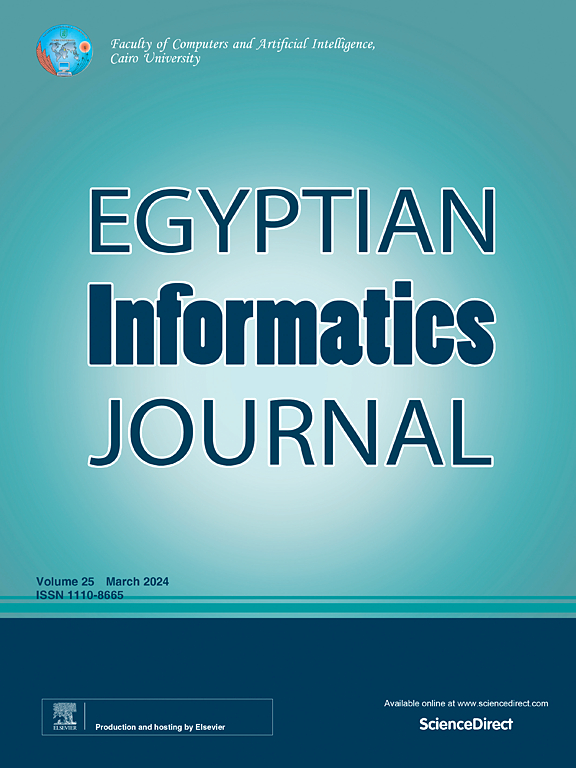Enhancing wireless sensor network performance through self-tuned fuzzy logic, adaptive palm tree optimization, and Stackelberg Game-Theoretic load balancing: A comprehensive approach for energy efficiency, reliability, and security
IF 4.3
3区 计算机科学
Q1 COMPUTER SCIENCE, ARTIFICIAL INTELLIGENCE
引用次数: 0
Abstract
A wireless sensor network (WSN) is a network of geographically scattered sensors that collects and transmits environmental data to a central processing station. Despite their extensive usage in environmental monitoring, military surveillance, and healthcare, WSNs present considerable challenges, including energy efficiency, network durability, and data transfer reliability. High energy consumption, irregular data throughput, packet loss, and lower network lifetime have detrimental effects on WSN performance, particularly in dynamic and large-scale configurations. This work introduces an innovative three-layer framework aimed at improving clustering, routing, and load balancing in Wireless Sensor Networks (WSNs). Initially, dynamic clustering is accomplished through a combination of Self-Tuned Fuzzy Logic and Adaptive Palm Tree Optimization (APTO), which considers energy, distance, throughput, and trust to effectively choose Cluster Heads (CHs). Next, the improved orbit optimization algorithm (IOOA) is utilized for selecting multi-hop routing paths and optimizing factors, such as energy usage, latency, and reliability. Finally, a Stackelberg Game-theoretic Approach (SGTA) is applied to ensure a fair load distribution among nodes, preventing overload, and boosting network stability. Together, these methods enhance the energy efficiency, reliability, and overall performance of the WSN. Simulation results demonstrate that the proposed approach, compared to existing algorithms such as the game-based dynamic clustering routing (GDCR) protocol, Game Theory-Based Fuzzy Routing Protocol (GTFR), Energy and Throughput Aware Adaptive Routing (ETAAR) algorithm based on Cooperative Game Theory (CGT), game theory inter-cluster routing, improved ant colony optimization (GTIACO), enhancement game, and gray wolf algorithm (EG-GWA) protocol, decreases energy consumption, improves throughput, extends network lifespan, and provides stability and reliability. The proposed method achieves an energy consumption of 15 mJ, packet delivery ratio (PDR), 0.98 Mbps of throughput, and 0.32 ms of jitter.
通过自调优模糊逻辑、自适应棕榈树优化和Stackelberg博弈论负载平衡增强无线传感器网络性能:一种能源效率、可靠性和安全性的综合方法
无线传感器网络(WSN)是一个地理上分散的传感器网络,它收集环境数据并将其传输到中央处理站。尽管无线传感器网络在环境监测、军事监视和医疗保健中得到了广泛的应用,但它面临着相当大的挑战,包括能源效率、网络耐久性和数据传输可靠性。高能耗、不规则数据吞吐量、丢包和较短的网络生命周期会对WSN的性能产生不利影响,特别是在动态和大规模配置中。这项工作引入了一个创新的三层框架,旨在改善无线传感器网络(wsn)中的聚类、路由和负载平衡。最初,动态聚类是通过自调优模糊逻辑和自适应棕榈树优化(APTO)的结合来实现的,APTO考虑了能量、距离、吞吐量和信任来有效地选择簇头(CHs)。其次,利用改进的轨道优化算法(IOOA)选择多跳路由路径并优化能耗、时延和可靠性等因素。最后,采用Stackelberg博弈论方法(SGTA)确保节点间负载公平分配,防止过载,提高网络稳定性。总之,这些方法提高了无线传感器网络的能源效率、可靠性和整体性能。仿真结果表明,与基于博弈的动态聚类路由(GDCR)协议、基于博弈论的模糊路由协议(GTFR)、基于协同博弈论(CGT)、博弈论集群间路由、改进蚁群优化(GTIACO)、增强博弈和灰狼算法(EG-GWA)协议等现有算法相比,该方法降低了能耗,提高了吞吐量。延长网络寿命,提供稳定性和可靠性。该方法实现了15 mJ的能耗、PDR (packet delivery ratio)、0.98 Mbps的吞吐量和0.32 ms的抖动。
本文章由计算机程序翻译,如有差异,请以英文原文为准。
求助全文
约1分钟内获得全文
求助全文
来源期刊

Egyptian Informatics Journal
Decision Sciences-Management Science and Operations Research
CiteScore
11.10
自引率
1.90%
发文量
59
审稿时长
110 days
期刊介绍:
The Egyptian Informatics Journal is published by the Faculty of Computers and Artificial Intelligence, Cairo University. This Journal provides a forum for the state-of-the-art research and development in the fields of computing, including computer sciences, information technologies, information systems, operations research and decision support. Innovative and not-previously-published work in subjects covered by the Journal is encouraged to be submitted, whether from academic, research or commercial sources.
 求助内容:
求助内容: 应助结果提醒方式:
应助结果提醒方式:


